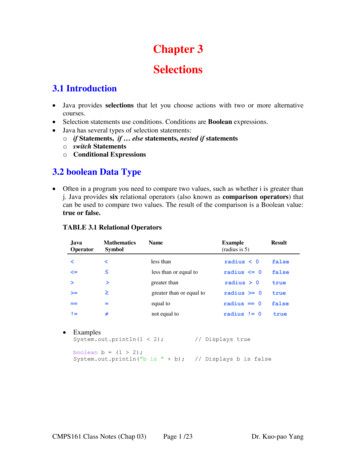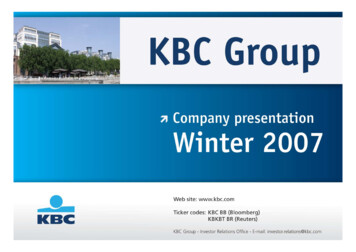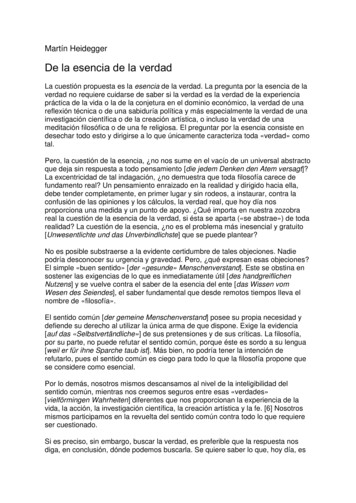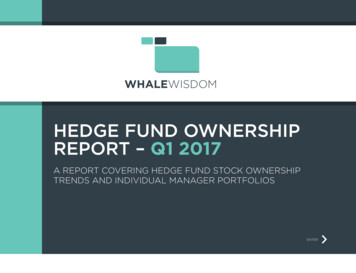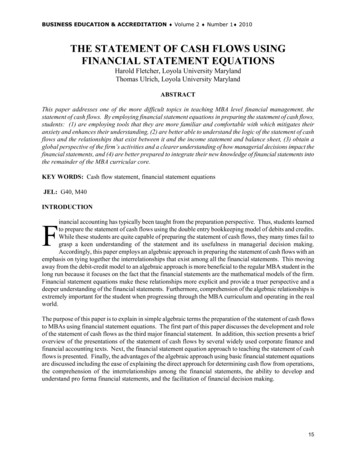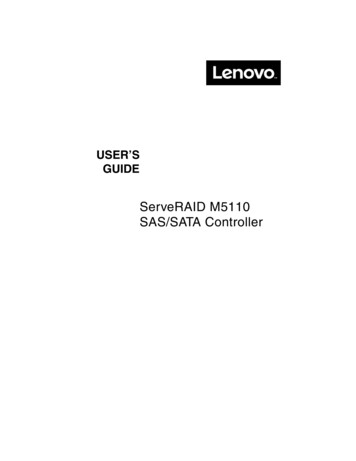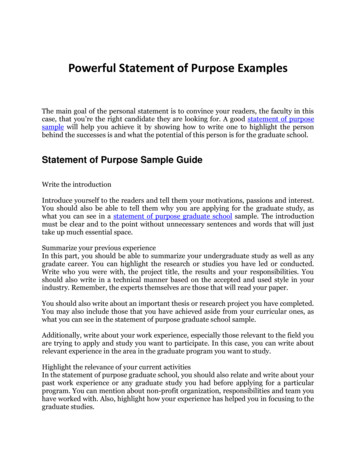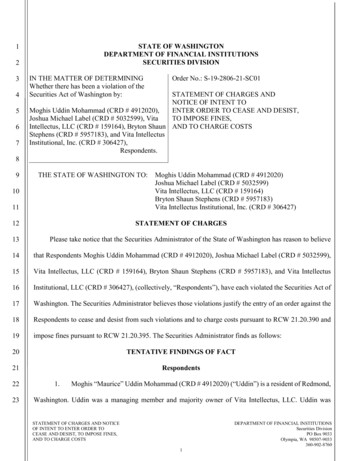
Transcription
STATE OF WASHINGTONDEPARTMENT OF FINANCIAL INSTITUTIONSSECURITIES DIVISION123456789IN THE MATTER OF DETERMININGWhether there has been a violation of theSecurities Act of Washington by:Order No.: S-19-2806-21-SC01STATEMENT OF CHARGES ANDNOTICE OF INTENT TOMoghis Uddin Mohammad (CRD # 4912020),ENTER ORDER TO CEASE AND DESIST,Joshua Michael Label (CRD # 5032599), VitaTO IMPOSE FINES,Intellectus, LLC (CRD # 159164), Bryton Shaun AND TO CHARGE COSTSStephens (CRD # 5957183), and Vita IntellectusInstitutional, Inc. (CRD # 306427),Respondents.THE STATE OF WASHINGTON TO:1011Moghis Uddin Mohammad (CRD # 4912020)Joshua Michael Label (CRD # 5032599)Vita Intellectus, LLC (CRD # 159164)Bryton Shaun Stephens (CRD # 5957183)Vita Intellectus Institutional, Inc. (CRD # 306427)STATEMENT OF CHARGES1213Please take notice that the Securities Administrator of the State of Washington has reason to believe14that Respondents Moghis Uddin Mohammad (CRD # 4912020), Joshua Michael Label (CRD # 5032599),15Vita Intellectus, LLC (CRD # 159164), Bryton Shaun Stephens (CRD # 5957183), and Vita Intellectus16Institutional, LLC (CRD # 306427), (collectively, “Respondents”), have each violated the Securities Act of17Washington. The Securities Administrator believes those violations justify the entry of an order against the18Respondents to cease and desist from such violations and to charge costs pursuant to RCW 21.20.390 and19impose fines pursuant to RCW 21.20.395. The Securities Administrator finds as follows:20TENTATIVE FINDINGS OF FACT21Respondents22231.Moghis “Maurice” Uddin Mohammad (CRD # 4912020) (“Uddin”) is a resident of Redmond,Washington. Uddin was a managing member and majority owner of Vita Intellectus, LLC. Uddin wasSTATEMENT OF CHARGES AND NOTICEOF INTENT TO ENTER ORDER TOCEASE AND DESIST, TO IMPOSE FINES,AND TO CHARGE COSTS1DEPARTMENT OF FINANCIAL INSTITUTIONSSecurities DivisionPO Box 9033Olympia, WA 98507-9033360-902-8760
1registered as an investment advisor representative for multiple firms between approximately February 20052and March 2020.32.Joshua “Josh” Michael Label (CRD # 5032599) (“Label”), is a resident of Bothell,4Washington. Label was the president, chief compliance officer, and minority owner of Vita Intellectus,5LLC. Label was registered as an investment advisor representative for multiple firms between6approximately November 2005 and April 2020.73.Vita Intellectus, LLC (CRD # 159164) was a Washington entity formed on October 14, 2011.8Formerly known as ULT Wealth Advisors, it changed its name to Vita Intellectus in approximately January92017. At various times since its formation, Vita Intellectus has been registered as an investment adviser10with the Securities Division and the Securities and Exchange Commission (“SEC”). It was administratively11dissolved by the Washington Secretary of State on March 3, 2021.124.Bryton Shaun Stephens (CRD # 5957183) (“Stephens”) is a resident of Bothell, Washington.13Stephens was an employee of Vita Intellectus and then president of Vita Intellectus Institutional, LLC when14it was formed in October 2019. Stephens was registered as an investment adviser representative between15approximately April 2019 and April 2020.165.Vita Intellectus Institutional, Inc. (CRD # 306427) was a Washington entity formed on17October 3, 2019. Vita Intellectus Institutional applied for registration as an investment adviser with the18Securities Division in approximately March 2020. It was administratively dissolved by the Washington19Secretary of State on March 3, 2021.206.Hereinafter, the term “Vita Respondents” shall refer to Respondents Uddin, Label, and Vita21Intellectus, and the term “VI Institutional Respondents” shall refer to Respondents Label, Stephens, and22Vita Intellectus Institutional.23STATEMENT OF CHARGES AND NOTICEOF INTENT TO ENTER ORDER TOCEASE AND DESIST, TO IMPOSE FINES,AND TO CHARGE COSTS2DEPARTMENT OF FINANCIAL INSTITUTIONSSecurities DivisionPO Box 9033Olympia, WA 98507-9033360-902-8760
Nature of the Conduct127.The Vita Respondents provided portfolio management and asset advice services to a mostly-3Washington state-based clientele. In the latter half of 2018, their client list ranged between approximately4130 and 145 clients. Clients ranged the spectrum of investment objectives and financial needs, from early-5career investors intending to grow their assets to retirees relying on their portfolio to cover their living6expenses or to pass on wealth to their children.78.Respondents Uddin and Label structured their firm so that Label was primarily responsible8for client-facing and compliance functions, and Uddin was primarily responsible for managing and9executing trades in clients’ portfolios.109.Respondent Label would meet with clients to assess their financial objectives and risk11tolerance, which could be assessed over multiple meetings. Label would walk clients through the firm’s12investment strategy for client accounts. Label told clients that their funds would be in three “buckets”: most13commonly, Label stated that the buckets were segregated between cash or cash equivalents, bonds, and14stocks, but for at least one client these buckets were segregated between low-risk, medium-risk, and high-15risk investments.1610.Respondent Label told clients that funds would be moved between buckets to take advantage17of market opportunities, and that market downturns would see more funds moved into the cash bucket.18Respondent Label gave clients various figures for the amount of their assets that were in cash or cash19equivalents.2011.Respondent Label discussed with some clients from the start of their client relationship the21potential for their assets to be traded using a “high frequency trading” (HFT) strategy. While HFT strategies22are generally understood to involve close to split-second executions by computer programs to achieve gains23or limit losses, here the HFT strategy, which was also referred to as a “high volume trading” strategy,STATEMENT OF CHARGES AND NOTICEOF INTENT TO ENTER ORDER TOCEASE AND DESIST, TO IMPOSE FINES,AND TO CHARGE COSTS3DEPARTMENT OF FINANCIAL INSTITUTIONSSecurities DivisionPO Box 9033Olympia, WA 98507-9033360-902-8760
1involved Respondent Uddin manually reviewing market trends and deciding to buy and sell blocks of2securities during the same trading day. The gains and/or losses would then be allocated across clients’3accounts.412.Respondent Label did not discuss HFT with other clients, and these clients were told that the5assets allocated for equity purchases were invested for long-term gains, with some variability for current6market conditions.713.All clients were provided a brochure by Respondent Label (“ADV Brochure”). The Vita8Respondents were required to provide the ADV Brochure as part of the firm’s registration requirements9under state and federal law. An ADV Brochure is the primary way an investment adviser discloses key10information about the firm to prospective and continuing clients. This brochure requirement is intended to11allow investors to access clear and understandable information about the firm’s investment strategies,12conflict of interests, and the background of the firm and its personnel.1314.In its ADV Brochure, the Vita Respondents disclosed three services they provided: a14Comprehensive Wealth Advisory Service, a Private Client Group service, and an Asset Management15service. The Vita Respondents described their Comprehensive Wealth Advisory Service as follows:1617181920212223Our Comprehensive Wealth Advisory Service encompasses asset management as well asproviding financial planning/financial consulting to clients for a single advisory fee. It isdesigned to assist clients in meeting their financial goals through the use of financialinvestments. We conduct at least one, but sometimes more than one meeting (in person ifpossible, otherwise via telephone conference) with clients in order to understand their currentfinancial situation, existing resources, financial goals, and tolerance for risk Based on what welearn, we propose an investment approach to the client. We may propose an investmentportfolio, consisting of exchange traded funds, mutual funds, individual stocks or bonds, orother securities. Upon the client's agreement to the proposed investment plan, we work with theclient to establish or transfer investment accounts so that we can manage the client's portfolio.Once the relevant accounts are under our management, we review such accounts on a regularbasis and at least quarterly. We may periodically rebalance or adjust client accounts under ourmanagement. If the client experiences any significant changes to his /her financial or personalcircumstances, the client must notify us so that we can consider such information in managingthe client's investments.STATEMENT OF CHARGES AND NOTICEOF INTENT TO ENTER ORDER TOCEASE AND DESIST, TO IMPOSE FINES,AND TO CHARGE COSTS4DEPARTMENT OF FINANCIAL INSTITUTIONSSecurities DivisionPO Box 9033Olympia, WA 98507-9033360-902-8760
123456789101112131415161718192021222315.The Vita Respondents disclosed that their Private Client Group service was offered to“qualified clients.” For this service, qualified clients would be offered the Vita Respondents’Comprehensive Wealth Advisory Service as described above, but would be charged an additionalperformance fee for it. A qualified client is a defined term under federal and state regulation which requiredthe client to, at the time of the relevant conduct, to have at least 1 million in assets under management withthe investment adviser or have a net worth of at least 2 million, not including the value of the client’sprimary residence.16.The Vita Respondents described their Asset Management Service as follows:As part of our Asset Management service, a portfolio is created, consisting of individual stocks,bonds, exchange traded funds ("ETFs"), options, mutual funds and other public and privatesecurities or investments. The client's individual investment strategy is tailored to their specificneeds and may include some or all of the previously mentioned securities. Portfolios willbe designed to meet a particular investment goal, determined to be suitable to the client'scircumstances. Once the appropriate portfolio has been determined, portfolios are continuouslyand regularly monitored, and if necessary, rebalanced based upon the client's individual needs,stated goals and objectives. Assets are managed by our firm on a discretionary or nondiscretionary basis, as indicated in the signed client agreement.17.The Vita Respondents disclosed a number of investment strategies that they could engage in,“provided that such strategies are appropriate to the needs of the client and consistent with the client'sinvestment objectives, risk tolerance, and time horizons, among other considerations.” As disclosed by theVita Respondents, these strategies were: Long-Term Purchases: (Securities Held At Least a Year); ShortTerm Purchases; Trading; High Frequency Trading (HFT); Short Sales; Margin Transactions; and OptionWriting. These strategies varied in risk, and would require the Vita Respondents analyze which ones werein their clients’ best interests.18.The Vita Respondents specifically disclosed the following for their use of HFT:We utilize HFT for our Private Client Group. High frequency trading is characterized by a highnumber of orders and transactions, and a low average profit per trade. Typical position holdingSTATEMENT OF CHARGES AND NOTICEOF INTENT TO ENTER ORDER TOCEASE AND DESIST, TO IMPOSE FINES,AND TO CHARGE COSTS5DEPARTMENT OF FINANCIAL INSTITUTIONSSecurities DivisionPO Box 9033Olympia, WA 98507-9033360-902-8760
1234567891011121314151617181920212223periods for HFT strategies range from a few seconds to a few hours. In most cases, positionsare not held overnight. Identifying and capitalizing on temporary market inefficiencies, HFTrelies on highly sophisticated technology infrastructures and massive amounts of intra-daymarket data. Although HFT can be applied to any sufficiently liquid electronically-tradedfinancial instrument, most active HFT strategies currently operate in equity foreign exchangeand derivatives markets.We maintain up to 25% of the clients' holdings as a satellite portfolio for short term marketswings depending on market conditions. Frequency of trading could range from intraday, todaily, to weekly, up to a month for holding times depending on market conditions. Thesestrategies are deployed in highly volatile positions to try to capture the spreads and opportunitiesavailable in the high volatile positions.19.Until approximately September 2018, a larger number of accounts were traded by the VitaRespondents in a long-term holding strategy consistent with the strategies outlined in client meetings andthe disclosures made in the ADV Brochure.Change of Custodians20.Until September 2018, client accounts that were traded by the Vita Respondents were held atCustodian #1, a large multinational financial services firm. At Custodian #1, a client account had to holdat least 110,000 in investable assets before the Vita Respondents traded it in a HFT strategy.21.In approximately May 2018, Custodian #1 detected unusual trading activity in accountsmanaged by the Vita Respondents. Specifically, Custodian #1 suspected that positive trades were beingintentionally allocated to favored client accounts, a concept known as “cherry-picking.” Cherry-picking isa violation of state and federal securities laws and inconsistent with an investment adviser’s fiduciary dutyto its clients.22.Custodian #1 questioned the Vita Respondents about their allocation practices, but foundthat the Vita Respondents could not adequately explain their conduct. In approximately August 2018,Custodian #1 told the Vita Respondents that it was terminating their access to its investment managementplatform and that they would lose access in November 2018.STATEMENT OF CHARGES AND NOTICEOF INTENT TO ENTER ORDER TOCEASE AND DESIST, TO IMPOSE FINES,AND TO CHARGE COSTS6DEPARTMENT OF FINANCIAL INSTITUTIONSSecurities DivisionPO Box 9033Olympia, WA 98507-9033360-902-8760
123.While the Vita Respondents had previously explored the use of other account custodians,2they were forced into using another custodian by Custodian #1’s decision to terminate their investment3management privileges. The day they received the termination notice from Custodian #1, the Vita4Respondents began to advertise to their clients their decision to use Custodian #2, a smaller financial5services firm, as Vita’s account custodian going forward.624.The Vita Respondents did not disclose to clients that Custodian #1 had terminated their use7of its investment management platform. Instead, in an email to their clients, the Vita Respondents stated8that their departure from Custodian #1 was based on “mutual agreement” with Custodian #1, and told9their clients in promotional material and in client meetings that it chose to move to Custodian #2 because10of a list of purported benefits that distinguished Custodian #2 from Custodian #1. This deprived their11clients of key information about whether to continue their client relationship with the Vita Respondents,12and deprived future clients of material information in deciding whether to use the Vita Respondents’13investment advisory services.141525.assets with the HFT strategy.Use of HFT Trading, Leveraged ETFs, and Account Losses1617Using Custodian #2, the Vita Respondents were now able to trade a broader range of client26.The Vita Respondents did not analyze whether the HFT strategy, in general or trading any18specific percentage of their assets, was in the best interests of their clients. They failed to disclose to many19clients that they began to trade their assets using an HFT strategy. They also failed to disclose that they20did not differentiate clients’ trading strategies based on their risk objectives, instead considering other21assets, such as rental properties, as bringing down the client’s overall investment risk. Indeed, the Vita22Respondents traded most of their client’s assets in the same manner, despite their disclosures that a23client’s “individual investment strategy is tailored to their specific needs.”STATEMENT OF CHARGES AND NOTICEOF INTENT TO ENTER ORDER TOCEASE AND DESIST, TO IMPOSE FINES,AND TO CHARGE COSTS7DEPARTMENT OF FINANCIAL INSTITUTIONSSecurities DivisionPO Box 9033Olympia, WA 98507-9033360-902-8760
127.For those clients with which they did discuss trading their accounts according to a HFT2strategy, the Vita Respondents did not disclose the specific risks of HFT strategies, including increased3trading fees, increased exposure to losses, and the reliance of the strategy on market timing.45628.These actions and omissions made the Vita Respondents’ ADV Brochure, as delivered totheir clients, misleading.29.Additionally, the Vita Respondents’ traded client assets in this riskier strategy despite7clients’ specific statements and risk profiles to the contrary. For example, Client #1, who was 60 at the8time, had recently lost her job, had trouble finding new employment, and previously emailed to9Respondent Label that she wanted an “income-generating and conservative approach” for her10investments. The majority of Client #1’s assets were in her tradable accounts managed by the Vita11Respondents, and in 2018 she reported only 9,600 in income. Client #2, a retired couple who had worked12as government employees and also had the majority of their assets in tradeable accounts managed by the13Vita Respondents, repeatedly expressed their misgivings with the HFT trading strategy, and, in the14months before they ended their client relationship with the Vita Respondents, told them to cease “day15trading” in their accounts. The Vita Respondents ignored these concerns and explicit directives.16171830.The Vita Respondents’ clients who were traded in this strategy immediately began to seelosses after the Vita Respondents began to trade their assets on Custodian #2’s platform.31.These losses were a result of the Vita Respondents’ HFT strategy, as well their decision to19hold certain riskier financial products, known as leveraged ETFs, in clients’ accounts. Leveraged ETFs20are a type of electronically traded fund that magnify the gains or losses of the index to which the fund is21tied. For example, one of the leveraged ETFs in which the Vita Respondents commonly invested, the22“Direxion Daily Small Cap Bull 3X ETF,” was tied to the performance of the Russell 2000 Index, which23tracked the performance of the 2000 stocks with the smallest market capitalization on the Russell 3000STATEMENT OF CHARGES AND NOTICEOF INTENT TO ENTER ORDER TOCEASE AND DESIST, TO IMPOSE FINES,AND TO CHARGE COSTS8DEPARTMENT OF FINANCIAL INSTITUTIONSSecurities DivisionPO Box 9033Olympia, WA 98507-9033360-902-8760
1Index. As a 3X ETF, it exposes investors to 300% positive or negative return on the benchmark index for2a single day. At the end of a trading day, the EFT rebalances, meaning that the fund manager modifies the3holdings of the ETF to keep it consistent with its objective of maintaining this 300% exposure. This4means that holding the leveraged ETF for multiple trading days decouples the investor’s exposure from5that of the fund, giving them potentially much more or much less exposure depending on the movement6of the market.789101112131415161718192021222332.These risks were disclosed by the ETF’s prospectus at the time, which included statementssuch as:The Direxion Daily Small Cap Bull 3X Shares (the “Fund”) seeks daily leveraged investmentresults and is very different from most other exchange-traded funds. As a result, the Fund maybe riskier than alternatives that do not use leverage because the Fund’s objective is to magnifythe daily performance of the Russell 2000 Index (the “Index”). This means that the return ofthe Fund for a period longer than a trading day will be the result of each trading day’scompounded return over the period, which will very likely differ from 300% of the return ofthe Index for that period. As a consequence, longer holding periods, higher volatility of theIndex and greater leverage increase the impact of compounding on an investor’s returns. Duringperiods of higher Index volatility, the volatility of the Index may affect the Fund’s return asmuch as, or more than, the return of the Index. Further, the return for investors that invest forperiods less than a trading day will not be 300% of the performance of the Index for the tradingday.33.Similar disclosures were made in the prospectuses of other ETFs traded by the VitaRespondents, and a longstanding investor alert jointly issued by the SEC and the Financial IndustryRegulatory Authority explains the risks of these products, including that, “because leveraged and inverseETFs reset each day, their performance can quickly diverge from the performance of the underlying indexor benchmark. In other words, it is possible that you could suffer significant losses even if the long-termperformance of the index showed a gain.”34.Despite the fund sponsors’ disclosures and regulatory risk alerts, the Vita Respondentsconsistently held these types of products in their clients’ accounts for much longer than a single tradingSTATEMENT OF CHARGES AND NOTICEOF INTENT TO ENTER ORDER TOCEASE AND DESIST, TO IMPOSE FINES,AND TO CHARGE COSTS9DEPARTMENT OF FINANCIAL INSTITUTIONSSecurities DivisionPO Box 9033Olympia, WA 98507-9033360-902-8760
1day. Additionally, the Vita Respondents did not disclose to their clients the role of leveraged ETFs in their2investment strategies, the manner in which they were used, and the resulting risks that were involved. The3Vita Respondents also did not disclose to clients that they were holding leveraged ETFs for weeks at a4time, and furthermore, that this was inconsistent with the client’s risk profile.535.For example, at the end of November 2018, the Vita Respondents had invested 53.8% of6Client #1’s remaining tradeable assets in leveraged ETFs, including 607 shares in the Direxion Daily7Small Cap Bull 3X ETF. These 607 shares were worth 36,665.90, which at this point already constituted8a 22,148.36 unrealized loss for Client #1 in that positon. From then, the Vita Respondents purchased 2109shares of the ETF on December 3, 2018, sold 317 shares the same day, purchased 534 shares on10December 4, 2018, and then held all of those shares until December 21, 2018, when they sold 934 shares11for a realized loss of 45,368.57. Similar activity occurred with other leveraged ETFs in Client #1’s12account, and that, combined with the HFT strategy, resulted in a 245,883.74 realized loss for Client #113that month, adding to the trading losses Client #1 had already sustained because of the Vita Respondents’14trading activity during this time period.1536.The above trading decisions came after the Vita Respondents had already incurred16substantial realized and unrealized losses in client accounts by the end of October 2018. For example,17Client #1 had seen account losses in October 2018 in the amount of 165,130.46, or approximately1822.35% of her accounts’ value.1937.Between September and December 2018, because of the Vita Respondents’ trading20decisions and management fees, Client #1 sustained 383,021.12 in realized losses, or about 49.93% of21her assets in the accounts that the Vita Respondents managed. Other clients lost substantial proportions of22their assets due to Vita Respondents’ trading decisions and fees. Client #2 realized losses of 268,109.70,23or about 35.95%, in their accounts, and Client #3, who were also a retired couple and around their 70s,STATEMENT OF CHARGES AND NOTICEOF INTENT TO ENTER ORDER TOCEASE AND DESIST, TO IMPOSE FINES,AND TO CHARGE COSTS10DEPARTMENT OF FINANCIAL INSTITUTIONSSecurities DivisionPO Box 9033Olympia, WA 98507-9033360-902-8760
1realized losses about 555,084.36, or about 34.2% of their account value. Client #4, one retired and one2still working, realized losses about 711,195.69, or about 42.45% of their account assets managed by the3Vita Respondents, during this four-month period.Lulling and Deflective Conduct4538.As clients began to complain about their account losses during this period, the Vita6Respondents deflected attention away from its trading strategy onto political and macroeconomic events.7In meetings, Respondent Label told clients that the losses were the result of market reactions to statements8made by the Federal Reserve chair or the U.S. president at the time. The Vita Respondents reinforced this9view by sending an email to their client list with the same talking points. This email, dated December 7,10111213141516171819202122232018, stated:Markets are dealing with a tremendous amount of cross currents, news and importantheadlines. Tariffs, Interest rates, and Brexit's. As discussed in an earlier note the U.S.economy is in pretty good shape, however, there is a lack of clarity coming from multiplesources. Furthermore, the headlines, statements, communications and tweets coming outof the White House for the last 10-12 weeks regarding China and the Trade War havedisrupted people's confidence in what to believe. This temporary state of confusion ismaking people feel like they are walking on eggshells, however, we believe there will notbe a full-blown Trade War, and a more diplomatic solution will be reached.39.This email also furthered the Vita Respondents’ misrepresentations that they were tradingclient accounts according to the three-bucket strategy they had discussed with clients, instead of the HFTstrategy in which they were now trading most client accounts:We believe it is our job to lead you through all situations and be your guiding light when it ismost needed. This situation will be similar in nature to all challenges it will pass and calm,disciplined investors will prevail. When market corrections happen like this sometimes, theylast longer and have short term severe price movements. At first it feels bad, and can be scary.Later on, the discipline to invest in bad time pays off in the form of investment gains. WeCompletely understand it is more enjoyable when markets work in our favor, however, we mustalso know that occasionally markets show their ugly face. It is in the ugly times, we lay thefoundation for future success. This is precisely why we have our needs-based philosophy (threebuckets).STATEMENT OF CHARGES AND NOTICEOF INTENT TO ENTER ORDER TOCEASE AND DESIST, TO IMPOSE FINES,AND TO CHARGE COSTS11DEPARTMENT OF FINANCIAL INSTITUTIONSSecurities DivisionPO Box 9033Olympia, WA 98507-9033360-902-8760
12345678910111213141516171819202140.The Vita Respondents omitted and failed to take responsibility for their trading strategy as thecause of their clients’ losses. While market indices were down during this period of time, the VitaRespondents’ magnified their clients’ losses by engaging in high-risk trading behavior. For example, theDow Jones Industrial Average was down about 9.98% in this four-month period, the S&P 500 was downabout 13.34%, and the NASDAQ Composite Index was down by about 17.96%. Even using the mostnegative index, these trading decisions caused losses for their clients substantially above that of the index.41.By telling clients that their losses were due to political and macroeconomic forces, rather thanthe Vita Respondents’ trading decisions, the Vita Respondents deprived their clients of key informationregarding the client relationship, also breaching their fiduciary duty to their clients. The information ofwhich clients were deprived included the performance of the Vita Respondents’ trading strategy, as well asthe risk to which the Vita Respondents’ had exposed client accounts.Vita Intellectus Institutional42.For the clients that remained, Respondents provided various reasons over the next year fortheir account losses, and multiple clients instituted private litigation against Respondents and Custodians#1 and #2.43.In approximately February 2020, Custodian #2 terminated the Vita Respondents’ access to itsplatform, depriving them of the ability to directly manage client accounts. In this same time period,Respondents Uddin and Label decided to close Respondent Vita Intellectus. However, Respondents Labeland Stephens were not yet finished trying to manage its clients’ money, and transitioned clients over toRespondent Vita Intellectus Institutional.2223STATEMENT OF CHARGES AND NOTICEOF INTENT TO ENTER ORDER TOCEASE AND DESIST, TO IMPOSE FINES,AND TO CHARGE COSTS12DEPARTMENT OF FINANCIAL INSTITUTIONSSecurities DivisionPO Box 9033Olympia, WA 98507-9033360-902-8760
144.Respondent Stephens was principal and chief compliance officer of Respondent Vita2Intellectus Institutional, and Respondent Label was its chief executive officer. Respondent Vita Intellectus3Institutional applied to the Securities Division to register as a state-level investment adviser.445.Unlike Respondent Vita Intellectus, Respondent Vita Intellectus Institutional did not directly5trade client accounts, but instead recommended trades for clients. Clients would then execute these trades6on their own. Similar to Respondent Vita Intellectus’ move between Custodians #1 and #2, the VI7Institutional Respondents failed to disclose to clients that they were barred from using two investment8management platforms. The VI Institutional Respondents instead communicated with clients in a dishonest9and misleading manner.101112131415161718192021222346.In an email sent to clients by the VI Institutional Respondents, they stated:Thank you for taking the time to read this letter. At Vita Intellectus we have always strived tobe at the forefront of change. The industry and been moving towards open architecture WealthAdvisory or true holistic wealth advisory. What this means is a true and complete look at yourassets beyond your investments accounts. With this in mind we ar
Vita Respondents, these strategies were: Long-Term Purchases: (Securities Held At Least a Year); Short-Term Purchases; Trading; High Frequency Trading (HFT); Short Sales; Margin Transactions; and Option Writing. These strategies varied in risk, and would require the Vita Respondents analyze which ones were in their clients' best interests. 18.
